2009 peregrine falcon breeding season
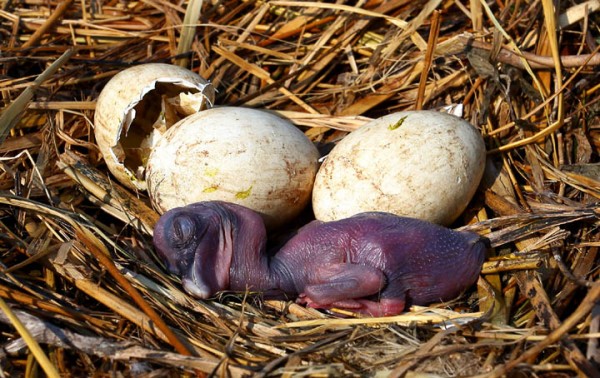
2008 Colonial Waterbird Survey Reveals some Species have Declined as Others Exploded in Virginia
May 8, 2009Winter investigations of sharp-tailed sparrows
May 10, 2009
Written by Elizabeth Mojica
May 9, 2009
Peregrine falcons in Virginia had another successful breeding season in 2009, producing 50 young falcons. The breeding population of falcons was extirpated in the state by the mid-1960s, but 30 years of intensive management efforts by The Center for Conservation Biology (CCB), in partnership with the Virginia Department of Game and Inland Fisheries and other organizations, have resulted in the current 21 breeding pairs.
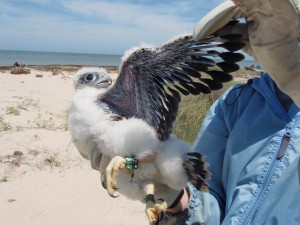
The flight feathers are still coming-in on this banded peregrine chick. Chicks are banded several weeks before they are able to fledge from their nest. Photo by the Center for Conservation Biology.
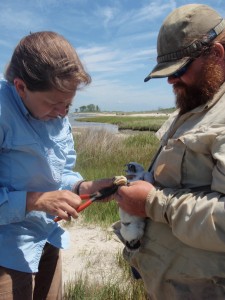
Center for Conservation Biology Biologists band a peregrine chick. Fletcher Smith holds a peregrine falcon chick as Libby Mojica fits a band on its leg, Watts Island, Virginia’s Eastern Shore. Photo by the Center for Conservation Biology.
Twenty falcon pairs made breeding attempts in 2009 producing 65 eggs and 50 chicks that survived to banding age. The reproductive rate was 2.4 chicks/occupied territory and 2.5 chicks/active territory. Of the 19 clutches that were followed completely from laying to fledging, 53 of 61 (86.9%) eggs hatched, 48 of the 53 (90.6%) chicks survived to banding age, and 41 (77.4%) fledged successfully.
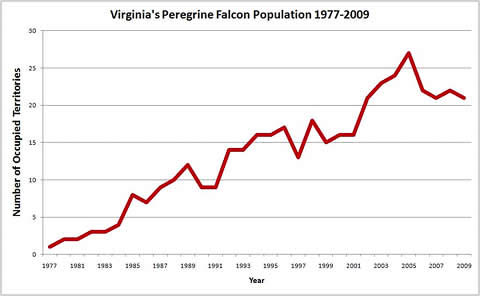
Breeding peregrine falcons in Virginia had a boost due to intensive reintroduction efforts starting in 1977, headed by Dr. Mitchell A. Byrd, co-founder of The Center for Conservation Biology. Graph by the Center for Conservation Biology.

A peregrine falcon chick hatched from Virginia’s Eastern Shore. Photo by Fletcher Smith.
A majority of the breeding pairs in Virginia nest on artificial structures: 10 man-made peregrine towers, 1 fishing shack, 6 bridges, 1 ship, 1 power plant stack, and 1 high-rise building. Chicks were removed from dangerous nest structures like bridges where there historically has been low fledging success. These chicks were translocated to the Virginia and West Virginia mountains as part of an on-going reintroduction program.
In 2009, CCB continued efforts to reintroduce falcons to the mountains through hacking programs at two National Parks: Shenandoah and New River Gorge. Nineteen young falcons from Virginia were released in the mountains this spring in the hopes they will return to breed on the rocky cliff faces that were their historic breeding sites. New breeding pairs were observed at both parks this year, confirming the success of the reintroduction program. The hacking program would not be possible without the continued support of the National Park Service and the state wildlife agencies of both Virginia and West Virginia.
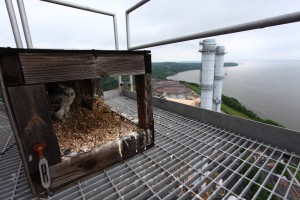
A new pair of peregrines nested on Dominion’s Possum Point power plant this year, fledging 2 young. Photo by Libby Mojica.
The ultimate goal of Virginia’s falcon program is to recover a population that is self-sustaining. Currently, the population’s dependence on artificial nest structures requires intensive management to reduce nest depredation and increase fledging success. CCB will continue to monitor population trends and improve reproductive performance through active management until we reach our goal for Virginia’s falcons.

On the barrier islands, peregrine falcons nest on platforms with man-made shelters. Research assistants, Julie Kelso and Dave Curtiss, remove peregrine chicks from a nest on Virginia’s Eastern Shore. Photo by Fletcher Smith.
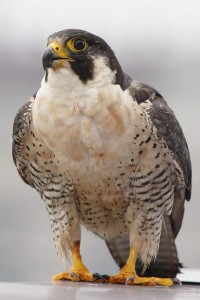
Adult female falcon breeding in downtown Richmond, VA on the roof of a building. The blood on her chest and legs is from a recent kill. Photo by Barton Paxton.
Peregrine falcon project partners:
The Center for Conservation Biology (CCB) with the Virginia Department of Game & Inland Fisheries Wildlife Diversity Program (VDGIF), National Aeronautics and Space Administration (NASA), National Parks Service (NPS), United States Fish & Wildlife Service (USFWS), Virginia Department of Transportation (VDOT), The Nature Conservancy (TNC), and Dominion Virginia Power.



